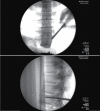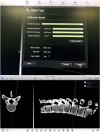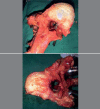ACCURACY OF PEDICLE SCREW INSERTION: A COMPARISON BETWEEN FLUOROSCOPIC GUIDANCE AND NAVIGATION TECHNIQUES
- PMID: 30774514
- PMCID: PMC6362689
- DOI: 10.1590/1413-785220182606180635
ACCURACY OF PEDICLE SCREW INSERTION: A COMPARISON BETWEEN FLUOROSCOPIC GUIDANCE AND NAVIGATION TECHNIQUES
Abstract
Objectives: To compare the accuracy of insertion of pedicle screws into the thoracic spine using fluoroscopic guidance or computer-assisted navigation techniques.
Methods: Eight cadaveric thoracic spines were divided into two groups: the fluoroscopy group, in which pedicle screws were inserted with the guidance of a C-arm device, and the navigation group, in which insertion of the screws was monitored using computer-assisted navigation equipment. All procedures were performed by the same spinal surgeon. The rate of pedicle breach was compared between the two groups.
Results: There was one intra-canal perforation in each group. Both perforations were medial in direction, and the breaches were 2 to 4 mm deep. There were no statistically significant differences in breach rate between the two groups.
Conclusions: The accuracy of insertion of pedicle screws in the thoracic spine using computer-assisted navigation is equivalent to that achieved using fluoroscopic guidance. Computer-assisted navigation improves the safety of the surgical team during the procedure due to the absence of exposure to radiation. Therefore, there is a need for future randomized controlled trials to be conducted in the clinical setting to evaluate other outcomes, including duration of surgery and blood loss during the procedure. Level of evidence IV.
Objetivos: Comparar a acurácia da inserção de parafusos pediculares na coluna torácica, utilizando fluoroscopia ou técnicas de navegação assistidas por computador.
Métodos: Estudo experimental com cadáveres. Oito colunas torácicas proveniente de cadáveres foram divididas em dois grupos: no grupo Fluoroscopia os parafusos pediculares foram inseridos com orientação de um aparelho tipo C-arm, e no grupo Navegação o monitoramento foi feito com um equipamento de assistência por computador. Todos os procedimentos foram feitos pelo mesmo cirurgião de coluna. A taxa de violação do canal foi comparada entre os grupos.
Resultados: Houve uma perfuração de canal em cada grupo, ambas mediais, com 2-4 mm de profundidade. Não houve diferenças significativas entre os dois grupos em termos de taxa de perfuração do canal.
Conclusão: A acurácia na inserção de parafusos pediculares na coluna torácica é igual comparando-se a navegação assistida por computador e o método de monitoramento por fluoroscopia. Como a segurança do procedimento para a equipe cirúrgica é maior com o método da navegação, devido à ausência de exposição à radiação, há necessidade de se realizarem estudos clínicos controlados no ambiente clínico, que avaliem outros desfechos, como o tempo de cirurgia e de sangramento. Nível de evidência IV.
Keywords: Fluoroscopy; Neuronavigation; Pedicle screw; Spinal fusion; Spine.
Conflict of interest statement
All authors declare no potential conflict of interest related to this article.
Figures





References
-
- Belmont PJ, Jr, Klemme WR, Dhawan A, Polly DW., Jr In vivo accuracy of thoracic pedicle screws. Spine (Phila Pa 1976) 2001;26(21):2340–2346. - PubMed
-
- Cotrel Y, Dubousset J. A new technique for segmental spinal osteosynthesis using the posterior approach. Rev Chir Orthop Reparatrice Appar Mot. 1984;70(6):489–494. - PubMed
-
- Krag MH, Weaver DL, Beynnon BD, Haugh LD. Morphometry of the thoracic and lumbar spine related to transpedicular screw placement for surgical spinal fixation. Spine (Phila Pa 1976) 1988;13(1):27–32. - PubMed
-
- Katonis P, Christoforakis J, Kontakis G, Aligizakis AC, Papadopoulos C, Sapkas G, et al. Complications and problems related to pedicle screw fixation of the spine. Clin Orthop Relat Res. 2003;(411):86–94. - PubMed
-
- Gautschi OP, Schatlo B, Schaller K, Tessitore E. Clinically relevant complications related to pedicle screw placement in thoracolumbar surgery and their management: a literature review of 35,630 pedicle screws. Neurosurg Focus. 2011;31(4):E8–E8. - PubMed
LinkOut - more resources
Full Text Sources
